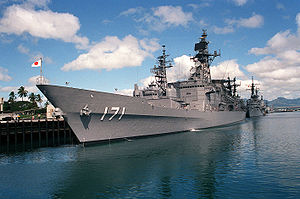This article needs additional citations for verification. (January 2009) |
 Hatakaze (DDG-171) docked in Pearl Harbor, 1988
| |
| Class overview | |
|---|---|
| Name | Hatakaze class |
| Builders | Mitsubishi Heavy Industries |
| Operators | |
| Preceded by | Tachikaze class |
| Succeeded by | Kongō class |
| Cost |
|
| Built | 1983–1988 |
| In commission | 1986–present |
| Completed | 2 |
| Active | 2 |
| General characteristics | |
| Type | Guided-missile destroyer |
| Displacement |
|
| Length | 150 m (492 ft 2 in) |
| Beam | 16.4 m (53 ft 10 in) |
| Draft | 4.8 m (15 ft 9 in) |
| Propulsion |
|
| Speed | 30 knots (56 km/h; 35 mph) |
| Complement | 260 |
| Armament |
|
The Hatakaze class of guided-missile destroyers is a third generation class of vessels in service with the Japan Maritime Self-Defense Force (JMSDF). They were the first of the JMSDF's ships to have gas-turbine propulsion.
The core weapon suite is similar to that of the preceding Tachikaze class, but various improvements were made in many areas. Most notable are those that allow the Hatakaze class to function as a group flagship. Normally this duty resides with a larger type of ship, but in case of their absence due to repairs, accident, or battle damage, the Hatakaze design allows for it to function as a command ship.
Hatakaze destroyers operate the OYQ-4-1 type tactical control system. Its weapon systems include the Standard missile surface-to-air missile, anti-submarine rockets, the RGM-84 Harpoon anti-ship missile, two Mark 15 20 mm CIWS gun mounts, two torpedo mounts in a triple tube configuration and two 5 inch/54 caliber Mark 42 rapid-fire guns.